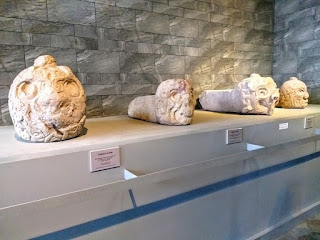 art restitution,Chavín de Huantar,Federal Office for Customs and Border Security,looted antiquities,Peru,Switzerland
art restitution,Chavín de Huantar,Federal Office for Customs and Border Security,looted antiquities,Peru,Switzerland
 No comments
No comments
A 2,500-year-old sculpture from the monumental ruins of Chavín de Huantar is returned to the Peruvian ambassador
 |
| The site of Chavín de Huantar |
What we know about the monumental ruins of Chavín de Huantar, thousands of feet up in the Cordillera Blanca, the Andean highlands of Peru, is spartan. Here, members of a pre-Inca culture, left us with what archaeologists believe to be a temple complex, consisting of a maze of ruined granite and sandstone structures – or step pyramids, cyclopean walls, and wonderful carved sculptures which date from around 1000 BCE.
Already mentioned in the sixteenth-century chronicles of Pedro Cieza de León, the site of Chavín de Huantar, is located kilometers north of Lima. It's unique architecture resulted in it being declared a World Cultural Heritage Site by the United Nations Educational, Scientific and Cultural Organization (UNESCO) in 1985.
Distinct, not only for its massive flat-topped pyramid temple, but also for what archaeologists call its "cabezas clavas," more commonly called temple nail heads. These front-facing, pumpkin sized heads, were architectural elements, and were usually carved from volcanic tuff and made to resemble zoomorphic faces. Used as decoration, they were positioned horizontally and equidistant from each other along the temple walls.
Usually, these nail heads, carved with open eyes, closed mouths, crushed noses, and contracted muscles. When found intact, they also have an elongated stone extension bracket on the back. This wedge was used to insert the sculptural element, like a nail, into the structure's wall, hence the name they were given. Many of the Chavín de Huantar nail heads were originally positioned along the south, east, and west façade of the Chavín temple, garnishing the building in a horizontal row and positioned evenly under the temple's carved stone cornices.
Some 42 nail heads were originally recorded and identified between 1919 and 1941 by Julio C. Tello, America's first indigenous archaeologist. Most of which were lost in the aftermath of a 1945 flood that covered the archaeological site. Others have been lost to looters.
Over time, as many as 100 complete or almost complete nail heads, discovered after 1950, have been found and preserved from the Chavín culture, with almost all of those accounted for coming from official excavations. These, are now part of the permanent collection of the National Museum of Chavín. Sadly, only a single original nail head remains in situ.
Yesterday, in a ceremony conducted at the Swiss customs office, Basel/Weil am Rhein-Autobahn, the president of the Office fédéral de la culture (OFC), Carine Bachmann, returned a smuggled nail head to Peru's Ambassador HE Luis Alberto Castro Joo. According to the OFC, this ancient architectural element, which weighs in at nearly 200 kilograms, was discovered by Swiss customs officials during a routine customs control check conducted in 2016 of a courier transporting the object from Germany into Switzerland.
Suspicious of the statements declared by the freight forwarder, who had tried to introduce the artefact into Switzerland as a "non-cultural good," and therefore not subject to specific heritage laws, employees of the Federal Office for Customs and Border Security - BAZG, stopped the object's entry to examine it more closely. Over time, and with the assistance of heritage experts, the Swiss authorities came to the conclusion that the artefact was, in fact, unregistered cultural property and moved for the artefact's seizure in accordance with the Cultural Property Transfer Act.
Shortly thereafter, during a cantonal criminal proceeding, an order of confiscation was entered by the Basel public prosecutor in 2017. This in turn allowed the artefact to be eventually restituted to the Government of Peru in the formal ceremony held yesterday.





